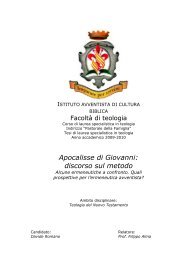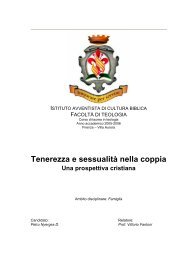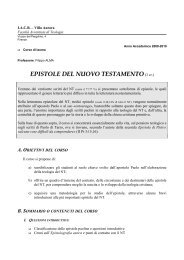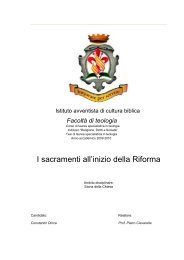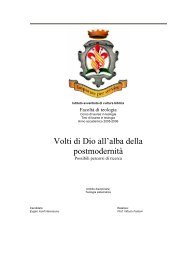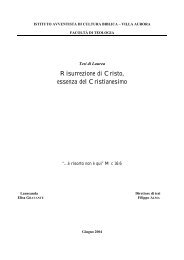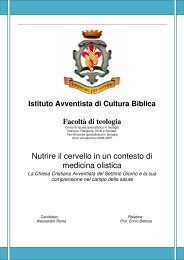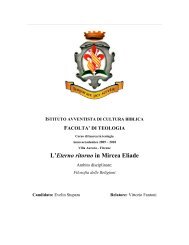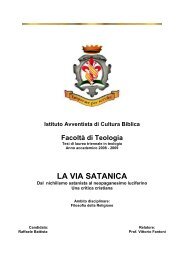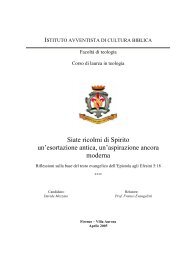Facoltà Avventista di Teologia - Istituto Avventista di Cultura Biblica
Facoltà Avventista di Teologia - Istituto Avventista di Cultura Biblica
Facoltà Avventista di Teologia - Istituto Avventista di Cultura Biblica
You also want an ePaper? Increase the reach of your titles
YUMPU automatically turns print PDFs into web optimized ePapers that Google loves.
PER L’A.A. 2010-2011 IL CORSO NON VERRA’ DATO PER ASSENZA DI ALLIEVI<br />
I.A.C.B. – Villa Aurora<br />
<strong>Facoltà</strong> <strong>Avventista</strong> <strong>di</strong> <strong>Teologia</strong><br />
Viuzzo del Pergolino, 4<br />
Firenze<br />
Anno Accademico 2010-2011<br />
Corso <strong>di</strong> laurea<br />
Corso <strong>di</strong> laurea specialistica<br />
<strong>Teologia</strong> Pastorale<br />
Corso <strong>di</strong> laurea specialistica<br />
Religione, <strong>di</strong>ritti e società<br />
A cura <strong>di</strong> Giuseppe Marrazzo<br />
OMILETICA<br />
1. Descrizione sintetica della materia: L’omiletica è una delle materie previste nell’ambito della <strong>Teologia</strong><br />
pratica (pastorale, catechesi, educazione, problematiche del matrimonio e famiglia, omiletica e altro).<br />
L’omiletica si occupa della teologia della pre<strong>di</strong>cazione e, in pratica, <strong>di</strong> come ideare, preparare, organizzare e<br />
comunicare il messaggio della fede, con l’intento <strong>di</strong> suscitare una risposta e una decisione in coloro che<br />
ascoltano. L’arte dell’omiletica ricalca altresì i temi trattati dalla scienza della comunicazione, che ha<br />
recuperato, in gran parte, i percorsi della retorica antica: cioè l’inventio (trovare cosa <strong>di</strong>re), <strong>di</strong>spositio<br />
(sistemare il materiale), memoria (fissare nella mente il piano <strong>di</strong> ciò che si vuole <strong>di</strong>re) ed espositio, (esporre<br />
in modo chiaro e gradevole).<br />
OBIETTIVI DEL CORSO<br />
a. Esaminare gli elementi <strong>di</strong> una buona pre<strong>di</strong>cazione biblica.<br />
b. Acquisire competenza e abilità nello svolgimento del ministero della Parola.<br />
c. Conseguire un buon livello <strong>di</strong> professionalità con esercitazioni pratiche volte a verificare se il<br />
can<strong>di</strong>dato sia in grado <strong>di</strong> utilizzare efficaci modalità comunicative.<br />
SOMMARIO O CONTENUTI DEL CORSO<br />
1. <strong>Teologia</strong> della Parola<br />
1.1 Che cos’è Parola <strong>di</strong> Dio?<br />
1.2 Chi è il pre<strong>di</strong>catore?<br />
1.3 Che cos’è una pre<strong>di</strong>cazione?<br />
1.4 Le qualità <strong>di</strong> un pre<strong>di</strong>catore<br />
2. La preparazione del sermone<br />
2.1 La scelta del testo<br />
2.2 In<strong>di</strong>viduare la punta del testo (esegesi)<br />
2.3 Ascoltare ciò che il testo mi vuole <strong>di</strong>re<br />
2.4 La persuasione e la retorica antica<br />
2.5 Strumenti della persuasione (logos, pathos, ethos)<br />
2.6 L’arte della comunicazione<br />
2.7 Strumenti <strong>di</strong> lavoro<br />
3. I principali tipi <strong>di</strong> sermone<br />
3.1 La pre<strong>di</strong>cazione narrativa<br />
3.2 I sermoni <strong>di</strong> circostanze (Cena, funerali, battesimo, matrimonio, presentazione dei bambini, ecc.)<br />
3.3 Verso altre forme <strong>di</strong> pre<strong>di</strong>cazione (immagini, ppoint, ecc.)<br />
3.4 Il sermone per i bambini<br />
4. La presentazione del sermone<br />
4.1 La cornice liturgica del sermone<br />
4.2 Abbigliamento adeguato<br />
4.3 Il linguaggio del sermone<br />
4.4 Coltivare la propria voce
5. Interpretazione e attualizzazione della Scrittura<br />
5.1 Meto<strong>di</strong> d’interpretazione della Scrittura<br />
5.2 I teologi del XX secolo<br />
5.3 I teologi della Parola<br />
5.4 La pre<strong>di</strong>cazione <strong>di</strong> Albert Schweitzer<br />
5.5 La pre<strong>di</strong>cazione <strong>di</strong> Bonhoeffer<br />
5.6 La pre<strong>di</strong>cazione <strong>di</strong> Martin Luther King<br />
ESIGENZE ACCADEMICHE PER LA CONVALIDA DEL CORSO (E CRITERI DI VALUTAZIONE)<br />
Lo studente deve <strong>di</strong>mostrare <strong>di</strong> aver acquisito competenze nelle modalità comunicative e nell’esame del testo<br />
biblico. La valutazione comprende una parte teorica (orale e scritta) e una pratica (esercitazione conclusiva).<br />
Il voto finale viene stabilito dalla me<strong>di</strong>a tra queste due valutazioni.<br />
BIBLIOGRAFIA<br />
AA.VV. La Pré<strong>di</strong>cation, Coor<strong>di</strong>nation E<strong>di</strong>fier & Former, Église réformée de France, Paris, 1996. (rifor.)<br />
AA.VV. La Bibbia e l’uomo moderno, Monboso, Grassoney, 1999.<br />
K. BARTH, Parola <strong>di</strong> Dio e parola umana, E<strong>di</strong>zioni scientifiche italiane, Napoli, 1999. (lut.)<br />
R. BARTHES, La retorica antica, Tascabili Bompiani, Milano, 2006.<br />
G. BARZAGHI, La filosofia della pre<strong>di</strong>cazione, e<strong>di</strong>zioni stu<strong>di</strong> domenicani, Dehoniane, Bologna, 1995. (catt/op)<br />
U. BECKER E D. MÜLLER, «Anghéllō» in Dizionario dei concetti biblici, Dehoniane, Bologna, 1980 pp. 1372-1375. (catt.)<br />
C. BISCONTIN, Pre<strong>di</strong>care bene, E<strong>di</strong>zioni Messaggero, Padova, 2008. (catt.)<br />
D. BONHOEFFER, La Parola pre<strong>di</strong>cata, Clau<strong>di</strong>ana, Torino, 1994. (lut.)<br />
Ch.E. BRADFORD, Preaching to the Times. The preaching Ministry in the Seventh-day Adventist Church, Min. Ass. (s.d.) (avv.)<br />
A. CARACCIOLO, Principi <strong>di</strong> omiletica, Seminario Teologico Villa Aurora, Firenze, 1990. (avv.)<br />
D. CARNEGIE, Come parlare in pubblico e convincere gli altri, Bompiani, Milano, 2007.<br />
E. CHARPENTIER, Per leggere il Nuovo Testamento, Borla, 1987. (catt.)<br />
A. CHURCH, <strong>Teologia</strong> della pre<strong>di</strong>cazione, E<strong>di</strong>zioni Paoline,Catania, 1970. (catt.)<br />
R.B. CIALDINI, Le armi della persuasione, Giunti-Barbera, Firenze, 1989.<br />
CICERONE, L’oratore, a cura <strong>di</strong> G. Barone, Oscar Mondadori, Milano, 1998.<br />
L. COENEN, «Kērýssō» in Dizionario dei concetti biblici, Dehoniane, Bologna, 1980 pp. 1375-1387.<br />
E. H. COPLEY, Omiletica, Ciclostilato in proprio da <strong>Istituto</strong> Biblico Evangelico, Roma. (evang.)<br />
B. CORSANI, Esegesi: come interpretare un testo biblico, Clau<strong>di</strong>ana, Torino, 1989. (vald.)<br />
F. B. CRADDOCK, Pre<strong>di</strong>care, l’arte <strong>di</strong> annunciare la Parola oggi, Ancora, Milano, 1997. (metod.)<br />
C. DELCORNO, La pre<strong>di</strong>cazione nell’età comunale, Sansoni, Firenze, 1974.<br />
I.H. EVANS, The Preacher and His Preaching, Review and Herald, Washington DC, 1938. (avv.)<br />
E. GENRE, Nuovi itinerari <strong>di</strong> teologia pratica, Clau<strong>di</strong>ana E<strong>di</strong>trice, Torino, 1991. (vald.)<br />
E. GENRE, «Pastorale giovanile e comunicazione del messaggio biblico agli adolescenti» art. in Protestantesimo vol. 56 n. 2/2001 pp. 67-78. (vald.)<br />
F. GIAMPICCOLI, Perché la Bibbia, Clau<strong>di</strong>ana, Torino. (vald.)<br />
N. HOLMES, Omiletica, come preparare e pre<strong>di</strong>care sermoni, Publielim, Milano, 2002. (evang.)<br />
A. KUEN, Come pre<strong>di</strong>care. L’arte <strong>di</strong> comunicare l’essenziale, E<strong>di</strong>trice Uomini Nuovi, Marchirolo, 2006 (evang.)<br />
H. LESÈTRE, «Pré<strong>di</strong>cation» art. in Dictionnaire de la Bible publié par F. Vigouroux, Paris, 1922, tome V col. 595-597.<br />
L. MALDONADO, L’omelia, pre<strong>di</strong>cazione, liturgia, comunità, E<strong>di</strong>zioni San Paolo, Cinisello B. (Mi), 1995. (catt.)<br />
G. ORLANDONI, Omelia: monologo o <strong>di</strong>alogo? La pre<strong>di</strong>cazione alla luce della sociologia della comunicazione, E<strong>di</strong>zioni Paoline,<br />
Cinisello Balsamo, 1977. (catt.)<br />
E. PARMENTIER, «Né soprabiti “coprimiserie”, né corsetti!», art. in Adventus n. 15/2005, pp. 80-94. (rifor.)<br />
C. PERELMAN e L. OLBRECHTS-TYTECA, Trattato dell’argomentazione. La nuova retorica, Einau<strong>di</strong>, Torino, 2001.<br />
R. PICON, Ré-enchanter le ministère pastoral, E<strong>di</strong>tion Olivétan, Lyon, 2007.<br />
A.R. PRATKANIS, E. ARONSON, Psicologia delle comunicazioni <strong>di</strong> massa, il Mulino, Bologna, 1992.<br />
O. REBOUL, Introduzione alla retorica, il Mulino, Bologna, 1996.<br />
R. RIZZO, Pre<strong>di</strong>care Cristo, E<strong>di</strong>zioni Adv, Impruneta, 2003. (avv.)<br />
H. W. ROBINSON, Pre<strong>di</strong>care la Bibbia, <strong>Istituto</strong> Biblico Evangelico, Roma, 1984. (evang.)<br />
B. ROSTAGNO, La fede nasce dall’u<strong>di</strong>re, Clau<strong>di</strong>ana, Torino, 1984. (vald.)<br />
J.R.W. STOTT, Between Two Worlds, The Art of Preaching in the Twentieth Century, Eerdmans, Grand Rapids, 1982. (evang.)<br />
A. VINET, Homilétique ou théorie de la pré<strong>di</strong>cation, 1853, www.epelorient.free.fr , 2005 (rifor.)<br />
P. WATZLAWICK, J.H. BEAVIN, D.D. JACKSON, Pragmatica della comunicazione umana, stu<strong>di</strong>o dei modelli interattivi delle patologie<br />
e dei paradossi, Casa E<strong>di</strong>trice Astrolabio, Roma, 1971.<br />
Ellen G. WHITE, Le Ministère évangelique, é<strong>di</strong>tion SdT, Dammarie Les Lys, 1951. (avv.)<br />
Ellen G. WHITE, Evangelism, Review and Herald, Washington DC, 1946 (Section 7 – The message and its presentation pp.168-216.<br />
Section 8 – Preaching the <strong>di</strong>stinctive truths, pp. 217-278). (avv.)<br />
Il Decano Il Direttore dell’IACB<br />
Hanz Gutierrez Tiziano Rimol<strong>di</strong>



